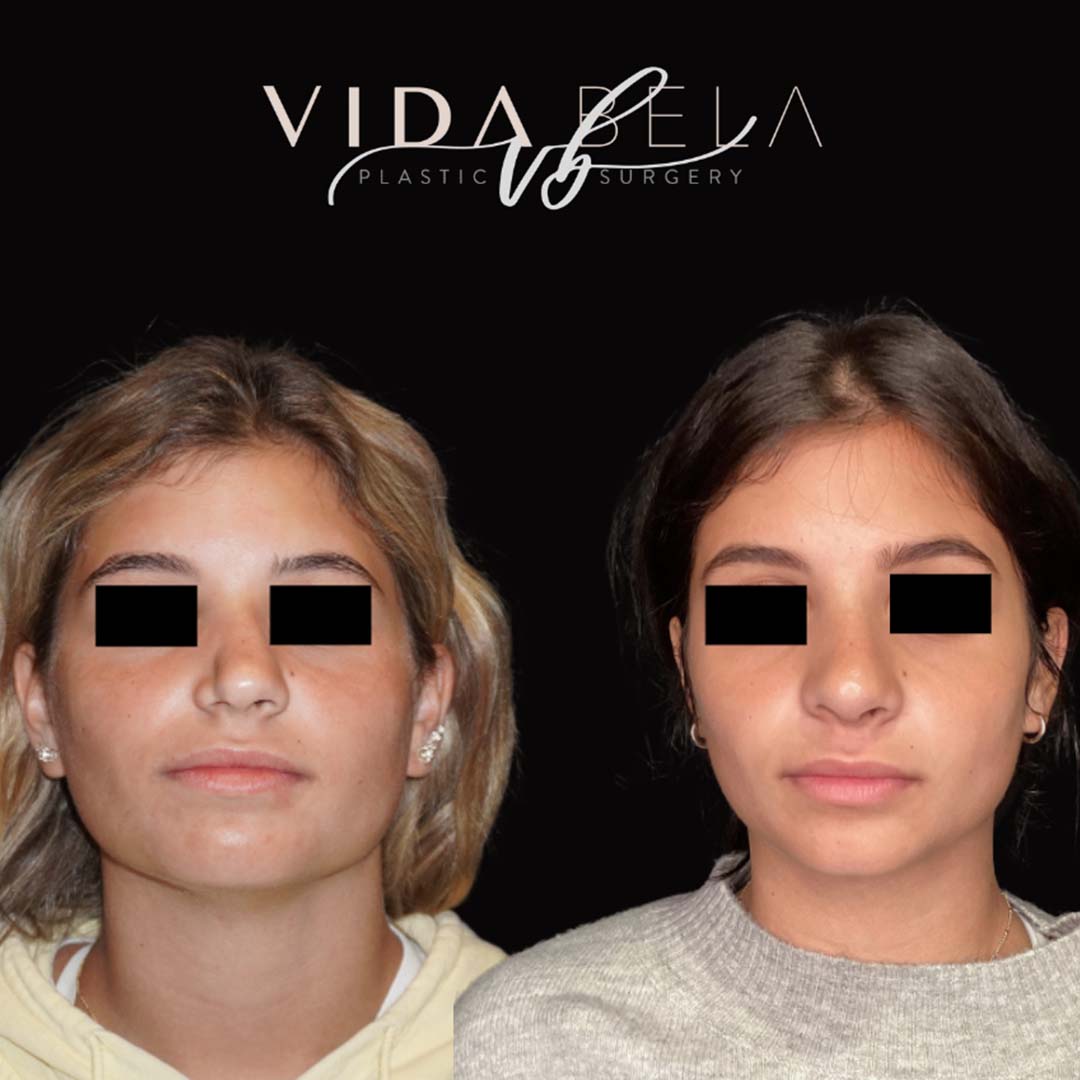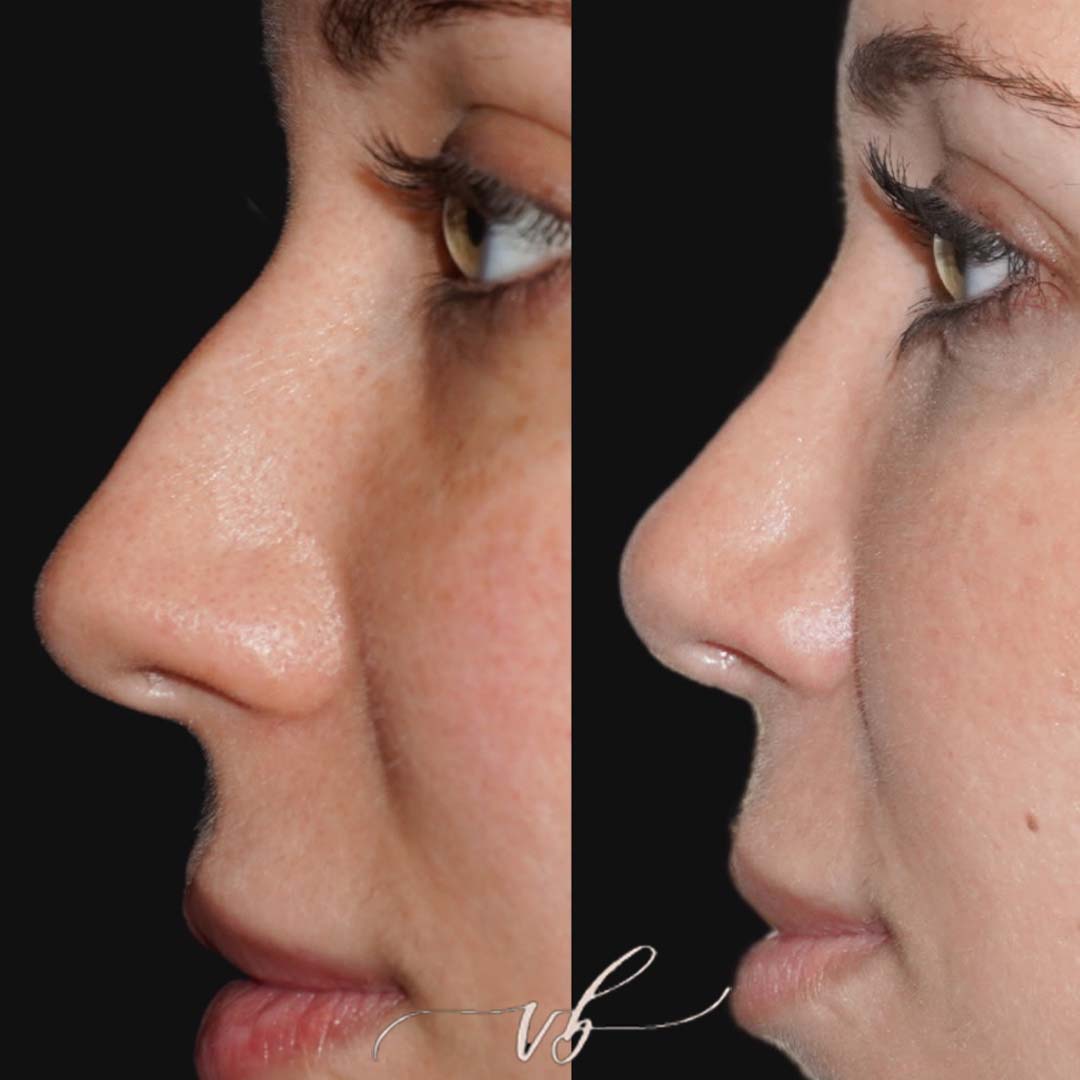Rhinoplasty, commonly known as a “nose job,” is a procedure aimed at enhancing the look or functionality of the nose. Dr. Snider, a board-certified plastic surgeon and devoted mother, specializes in this procedure to help her patients achieve their desired aesthetics.
Reshape & Harmonize Your Nose
Rhinoplasty, often referred to as a “nose job,” is a surgical procedure to reshape or reconstruct the nose. This surgery can address various concerns, including altering the size, shape, or symmetry of the nose, correcting nasal asymmetry, refining the nasal tip, or straightening a crooked nose. Beyond aesthetic enhancements, rhinoplasty can also improve nasal function, addressing issues such as breathing difficulties due to structural abnormalities or injury.
During a rhinoplasty, the surgeon makes incisions, either within the nostrils (closed rhinoplasty) or across the columella, the strip of tissue separating the nostrils (open rhinoplasty), to access and reshape the underlying bone and cartilage. The surgeon works meticulously to achieve the desired outcome while maintaining harmony with other facial features. Dr. Snider collaborates closely with her patients to understand their goals and concerns, ensuring results that closely conform to their ethnicity, goals, and anatomy.

Rhinoplasty Treats:
- Nasal asymmetry
- Nose size reduction or augmentation
- Correction of nasal bumps or depressions
- Refinement of nasal tip shape
- Straightening of a crooked nose
- Improvement of nasal breathing
- Correction of congenital deformities
- Reconstruction following injury or trauma
- Correction of structural abnormalities such as deviated septum
Advantages of Rhinoplasty:
- Improved self-confidence and self-esteem
- Enhanced facial aesthetics and harmony
- Correction of breathing difficulties
- Correction of nasal deformities or asymmetry
- Personalized customization to meet individual aesthetic goals
- Long-lasting results
- Potential improvement in sleep quality due to improved breathing
- Minimal scarring, especially with closed rhinoplasty techniques
- Ability to address both cosmetic and functional concerns simultaneously
- Increased satisfaction with overall facial appearance

Functional Rhinoplasty: Improve Nasal Breathing
Functional rhinoplasty is a surgical procedure that improves nasal breathing by addressing structural issues within the nose. Unlike cosmetic rhinoplasty, which focuses primarily on enhancing the appearance of the nose, functional rhinoplasty targets problems such as a deviated septum, nasal valve collapse, or other obstructions that hinder airflow. By correcting these issues, functional rhinoplasty enhances breathing and can alleviate symptoms such as chronic congestion, snoring, or sleep apnea. This procedure restores optimal nasal function.
Ethnic Rhinoplasty:
Preserve Markers Of Your Identity
Ethnic rhinoplasty is a specialized procedure tailored to preserve and enhance the unique nasal characteristics of individuals from diverse ethnic backgrounds. Unlike traditional rhinoplasty, which may create a more standardized or Eurocentric appearance, ethnic rhinoplasty respects the cultural and ethnic features of the nose. Dr. Snider considers factors such as skin thickness, nasal bridge width, and tip definition, ensuring the results complement your facial features without erasing the key markers of your ethnic identity or cultural heritage.
Teenage Rhinoplasty:
Elevate Your Teen’s Nasal Appearance
Teenage rhinoplasty is a surgical procedure performed on adolescents to enhance the appearance of the nose. It’s typically done to address aesthetic concerns such as a prominent dorsal hump, asymmetry, or nasal disproportion, which may cause self-consciousness or impact self-esteem during formative years. While the ideal age for teenage rhinoplasty depends on individual development, Dr. Snider often recommends waiting until the nasal structure has reached maturity, usually around 15 or 16 years old for girls and slightly older for boys.
Rhinoplasty: The Recovery Process
After the rhinoplasty procedure, your nose will be covered with a splint or packing to support the newly reshaped structures and minimize swelling. You may experience some discomfort, bruising, and swelling around the nose and eyes, which typically peaks within the first few days and gradually subsides over the following weeks. It’s common to have congestion and difficulty breathing through your nose during the initial stages of recovery.
You’ll need to diligently follow your surgeon’s post-operative instructions, which may include taking prescribed medications, avoiding strenuous activities, and keeping your head elevated to reduce swelling. While most of the visible swelling will diminish within the first few weeks, it may take several months for the final results to fully emerge as your nose settles into its new shape. Complete recovery can vary, but typically, you can expect to resume normal activities within a few weeks to a month after the procedure.

Rhinoplasty Aftercare Guidelines:
- Keep your head elevated while resting to reduce swelling.
- Take prescribed medications as directed by your surgeon.
- Apply cold compresses to your nose to alleviate discomfort and reduce swelling.
- Avoid strenuous activities and heavy lifting for several weeks.
- Keep the nasal area clean and dry, following your surgeon’s instructions for wound care.
- Attend all follow-up appointments with your surgeon for evaluation and monitoring.
- Be patient and allow your nose time to heal, avoiding excessive touching or manipulation.
- Follow a balanced diet and stay hydrated to support your body’s healing process.
- Wear protective clothing or sunscreen if you need to be in the sun to minimize scarring.
- Communicate any concerns or unusual symptoms to your surgeon promptly.
Rhinoplasty FAQs
Am I a suitable candidate for rhinoplasty?
If you’re unhappy with the size, shape, or symmetry of your nose, or if you’re experiencing breathing difficulties due to structural issues, you may be a candidate for rhinoplasty. Dr. Snider will carefully evaluate your nose and review your medical history to determine your candidacy.
How long does rhinoplasty surgery take?
The duration depends on the complexity of the surgery, but it typically lasts one to three hours.
What is the recovery time for rhinoplasty?
While the initial swelling and bruising subside within a few weeks, it may take several months for the final results to fully emerge as your nose settles into its new shape.
Will there be visible scarring after rhinoplasty?
The scars from rhinoplasty are well hidden within the natural contours of the nose or nostrils.
How long do the results of rhinoplasty last?
The results of rhinoplasty are long-lasting or permanent, but factors such as aging, injury, or significant weight fluctuations can affect the appearance of the nose over time.

Schedule Your Consultation
With Dr. Snider
Vida Bela Plastic Surgery is your gateway to transformative rhinoplasty led by Dr. Chelsea Snider, an exceptional board-certified plastic surgeon who also happens to be a devoted mother. With Dr. Snider, you’ll receive personalized care and understanding from a female surgeon who can empathize with your aesthetic goals and concerns. Take the first step toward enhancing your nose’s appearance and function by scheduling a consultation with Dr. Snider.

